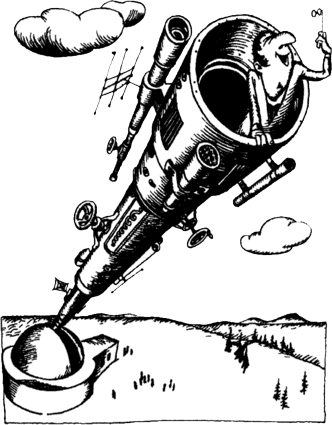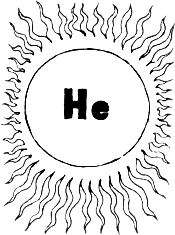107Stories About ChemistryINDEX |
80.
Chemical Analysis of... the Sun
In anticipation of the solar eclipse of 1868 astronomers, as always, prepared a great deal of equipment. This time the list included a spectroscope, the instrument which had not long before enabled the discovery of several new elements.  The eclipse passed, and everything settled back to normal. But on July 25, 1868, the French Academy of Science received two letters simultaneously, one from the shores of distant India from the Frenchman Janssen, and the other from England, from the Englishman Lockyer. The contents of both letters were the same almost word for word: each of the authors informed the Academy that he had, by means of spectrum analysis, discovered an element on the Sun that was unknown on Earth. It gave a yellow line in the spectrum, resembling the sodium line in colour. But this line had nothing to do with sodium. The esteemed assembly of scientists was greatly astonished. Janssen and Lockyer had not only succeeded in �analysing� the Sun, but were claiming to have discovered a new element as well!  On Earth helium (such was the name given to the �solar element�) was discovered only 27 years later, in 1895. In honour of this great event, the discovery of a method which made possible investigation of the secrets of the distant cosmic bodies, the French Academy passed a decision to coin a special medal. The method was indeed worth a special medal. By any other method at least a very small amount of substance must be available to perform the analysis with. Spectrum analysis defies all distances. After the discovery of the �solar element� scientists more than once trained their spectrographs (recording spectroscopes) on the Sun, and it meekly told them all about itself. After the Sun came the turn of other stars, near and distant. The glitter of stellar atmospheres reached the spectroscopes on Earth and in the silence of their laboratories scientists studied the intricate palisade of all kinds of spectral lines. In the heavenly bodies scientists found the elements that were already known on Earth. Only eighty years later did solar helium pass on the relay of scientific surprises to the element technetium, the one that occupied box 43 in the Mendeleyev Table. A ghost in terrestrial ores, technetium was first discovered in the spectra of certain stars, and only after that were traces of the element found on Earth. In the stars technetium is by no means a rare element. It forms in them continuously as a result of nuclear reactions. No more new elements were discovered on the Sun or in any of the stars, and probably never will be. The universe is uniform: the Earth, the Sun, the planets and stars and all the heavenly bodies in general consist of the same chemical elements. But the curious thing is that the �balance� of chemical elements in the skies is different from what it is on Earth. Not oxygen and silicon predominate in outer space, but hydrogen and helium. The amount of these first two representatives of the Periodic System in the universe is many times greater than that of all the rest of the elements taken together. See what a surprising paradox stellar chemistry brings us: our galaxy is primarily a kingdom of hydrogen. |





